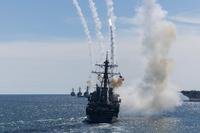The Navy says it is making headway on improving the quality of life for sailors stuck in shipyards during sometimes yearslong ship overhauls and nuclear refuelings following several high-profile suicide clusters and revelations about poor living conditions.
The Navy's Quality of Service Cross-Functional Team has spent the last six months trying to improve conditions for sailors at the Huntington Ingalls shipyard in Newport News, Virginia. The shipyard became well-known after conditions for sailors there deteriorated to the point that the aircraft carrier USS George Washington experienced "a 9/11-like event" of suicides in 2021 and early 2022.
Rear Adm. Christopher Gray, the team's leader, said during his first media interview in the role that he hopes his work will not only improve conditions at the shipyard but also provide upgrades to sailors' lives across the fleet. Navy officials also stressed that there is important work being done on updating service standards and ensuring sailors' experiences help keep them serving.
Read Next: VA Pauses Foreclosures on Veterans Facing Difficulties Making Mortgage Payments
Gray was direct about the events that led to his team's mission. Throughout the decades-long Global War on Terror, the Navy chose to fully fund resources at sea at the expense of shore installations "to make sure that the tip of the spear is sharp, that we have all the equipment and spare parts that we need for when we send people forward."
"But as we continued to do that over a longer period of time, we began to accumulate more and more risk which, oftentimes, goes unrecognized," Gray told reporters Monday at the Pentagon.
That risk resulted in conditions that recent Navy investigations revealed to be devastating to crew morale, readiness and mental health.
Command surveys about the George Washington, a ship that ended up spending six years in the Newport News shipyard, showed that thoughts of suicide grew rampant. Between 2019 and 2020, surveys from the ship showed that sailors' "awareness of suicidal ideations" ballooned from 31% to 56%.
The ship had nine suicides between November 2019 and its departure from the shipyard in May 2023. Another George Washington sailor, assigned to a maintenance center in nearby Norfolk, Virginia, also died by suicide in that time span as part of a separate suicide cluster.
A host of investigations and sailors themselves put much of the blame on a rush to move back aboard a ship that was still essentially a construction zone, a hodgepodge of parking options that turned commutes into hourlong affairs, and a climate of apathy from supervisors and leaders.
Rear Adm. John Meier, then commander of Naval Air Force Atlantic, wrote in a letter attached to one of the investigations stemming from the deaths, "It is safe to say that generations of Navy leaders had become accustomed to the reduced quality of life in the shipyard, and accepted the status quo as par for the course for shipyard life."
Gray told reporters that even before the suicides on the George Washington the Navy leadership was beginning to see that it had gone "a little bit too far" in cutting services.
"We needed to make changes," Gray said. The cluster of suicides aboard the George Washington "just put a finer point on that."
Capt. Patrick Thompson, the commander of the USS John C. Stennis aircraft carrier -- now in maintenance at Newport News like the George Washington -- told reporters Monday that the team's work has increased attention on his sailors and that has "allowed us to get after the issues" like parking much faster.
Thompson also noted that a pilot Wi-Fi program that has given sailors easier access to the internet has opened up "enormous" quality-of-life improvements.
Meanwhile, one Navy official told Military.com that the real value of the team's work is in establishing new policies, rules and standards for what the service considers acceptable living and working conditions.
"We are, for the first time, saying we're going to set [quality of service] policies and procedures and standards, we're going to test them out, and then we're going to see if they improve sailors' lives," the official said. "We can say, for example, we've increased access to medical care, but until we define the QoS standard, our sailors don't have a benchmark to measure off of."
The team, which meets every two weeks to create the standards and measure progress, is looking to improve access to medical care, food quality, and living and working conditions, and hopes to offer young sailors good opportunities to get training and experiences in their jobs.
Both the quality-of-service standards, as well as some improvements such as new Wi-Fi service, could have an effect across the fleet.
Gray said that the team has already studied the idea of offering Wi-Fi to sailors across all Navy bases -- it even has an estimated $90 million price tag -- but it is starting small to make sure that the service is something that sailors really want.
"We're doing this pilot to make sure that what we're getting our money's worth [and] that the sailors appreciate and are using that service," Gray said.
"If we rushed out and spent $90 million for Wi-Fi, only to find that the way we had implemented it, nobody was using it, then we would have wasted $90 million that we could have used to greater effect elsewhere," he added.
Gray also said that, long term, his team is looking to make the shipyard close to on-par with what sailors have available to them at a full installation like Naval Station Norfolk, just miles away from the shipyard where sailors suffered from poor living conditions.
"We probably won't create an installation there," Gray said. However, "we're going to look to mirror the services and the level of services that we can from an installation in the Newport News area because our sailors deserve it."
But Gray is cautious not to over-promise and stressed that his work will also dovetail with other efforts the Navy plans to announce soon.
"I think we just need a little more run-time to see if it's making a difference," Gray said. "What's really going to tell the story is as this begins to play out over a longer time, and we get more of the things that we're trying to do implemented."
-- Konstantin Toropin can be reached at konstantin.toropin@military.com. Follow him on X at @ktoropin.













